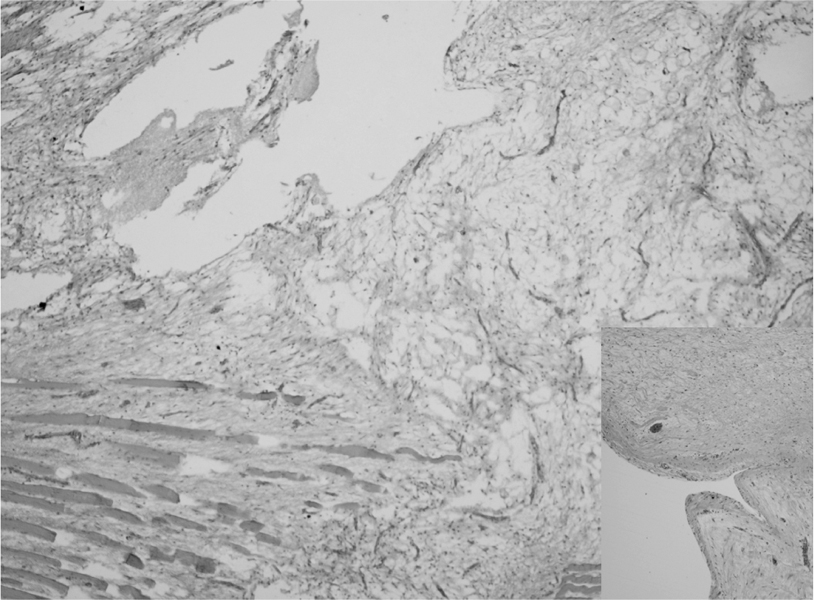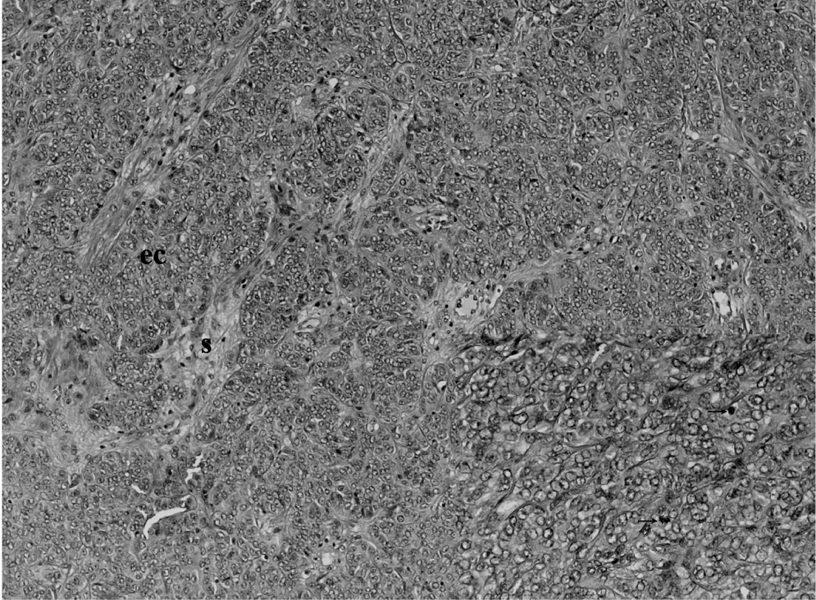Korean J Radiol.
2007 Oct;8(5):438-442. 10.3348/kjr.2007.8.5.438.
Mazabraud's Syndrome Coexisting with a Uterine Tumor Resembling an Ovarian Sex Cord Tumor (UTROSCT): a Case Report
- Affiliations
-
- 1Department of Radiology, Eskisehir Osmangazi University, Turkey. cuneytcalisir_72@yahoo.com
- 2Department of Orthopaedics and Traumatology, Eskisehir Osmangazi University, Turkey.
- 3Department of Pathology, Eskisehir Osmangazi University, Turkey.
- KMID: 1734293
- DOI: http://doi.org/10.3348/kjr.2007.8.5.438
Abstract
- The association of intramuscular myxoma and fibrous dysplasia is a rare disease known as Mazabraud's syndrome. We present a case of Mazabraud's syndrome coexisting with a uterine tumor and resembling an ovarian sex cord tumor (UTROSCT). This uterine tumor showed a high mitotic index and cytological atypia. To the best of our knowledge, the coexistence of the two different entities has not been reported in the literature.
Keyword
MeSH Terms
-
Aged
Biopsy
Buttocks/pathology/surgery/ultrasonography
Diagnosis, Differential
Female
Fibrous Dysplasia, Monostotic/complications/*diagnosis/surgery
Humans
Magnetic Resonance Imaging
Myxoma/complications/*diagnosis/surgery
Ovarian Neoplasms/*diagnosis
Rare Diseases
Sex Cord-Gonadal Stromal Tumors/*diagnosis
Syndrome
Uterine Neoplasms/complications/*diagnosis/surgery
Figure
Reference
-
1. Court-Payen M, Ingemann JL, Bjerregaard B, Schwarz LG, Skjoldbye B. Intramuscular myxoma and fibrous dysplasia of bone-Mazabraud's syndrome. Acta Radiol. 1997. 38:368–371.2. Clement PB, Scully RE. Uterine tumors resembling ovarian sex-cord tumors. Am J Clin Pathol. 1976. 66:512–525.3. Hendrickson MR, Longacre TA, Kempson RL. Sternberg SS, editor. The Uterine Corpus. Diagnostic surgical pathology. 1999. 3rd ed. Philadelphia: Williams & Wilkins;2269–2270.4. Iwasko N, Steinbach LS, Disler D, Pathria M, Hottya GA, Kattapuram S, et al. Imaging findings in Mazabraud's syndrome: seven new cases. Skeletal Radiol. 2002. 31:81–87.5. Mazabraud A, Girard J. A peculiar case of fibrous dysplasia with osseous and tendinous localizations. Rev Rhum Mal Osteoartic. 1957. 24:652–659.6. Wirth WA, Leavitt D, Enzinger FM. Multiple intramuscular myxomas. Another extraskeletal manifestation of fibrous dysplasia. Cancer. 1971. 27:1167–1173.7. Totty WG, Murphy WA, Lee JK. Soft tissue tumors: MR imaging. Radiology. 1986. 160:135–141.8. Prayson MA, Leeson MC. Soft-tissue myxomas and fibrous dysplasia of bone. A case report and review of the literature. Clin Orthop Relat Res. 1993. 291:222–228.9. Suzuki C, Matsumoto T, Fukunaga M, Itoga T, Furugen Y, Kurosaki Y, et al. Uterine tumors resembling sex-cord tumors producing parathyroid hormone-related protein of the uterine cervix. Pathol Int. 2002. 52:164–168.10. Okada S, Uchiyama F, Ohaki Y, Kamoi S, Kawamura T, Kumazaki T. MRI findings of a case of uterine tumor resembling ovarian sex-cord tumors coexisting with endometrial adenoacanthoma. Radiat Med. 2001. 19:151–153.
- Full Text Links
- Actions
-
Cited
- CITED
-
- Close
- Share
- Similar articles
-
- A case of uterine tumor resembling ovarian sex-cord tumor with clinical review
- A case of uterine tumor resembling ovarian sex-cord tumor
- Two Cases of Uterine Tumors Resembling Ovarian Sex-cord Tumors: Rare Case of Uterine Tumor
- Successful delivery after conservative resectoscopic surgery in a patient with a uterine tumor resembling ovarian sex cord tumor with myometrial invasion
- Uterine Tumor Resembling Ovarian Sex-Cord Tumor: A case report





